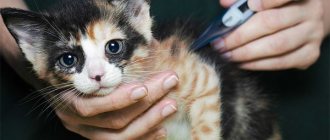It is useful for every responsible owner to know what the normal body temperature should be for cats and kittens. This important indicator is the main indicator of health, helping to identify the disease before dangerous changes occur. The deviations that arise are not always explained by pathology, therefore, in addition to the cat’s body temperature, it is necessary to take into account the accompanying symptoms and the general condition of the pet.
What temperature is considered normal for cats?
The body temperature of cats and cats is individual. First of all, it depends on metabolism, which varies depending on gender and age. Higher rates are typical for young males, and lower rates for older females.
In small kittens
A newborn kitten's temperature is the same as its mother's. In the first 3 weeks it gradually decreases to 35.5-36.5°C. The baby’s thermoregulation mechanism is still developing, so such fluctuations are absolutely normal.
From the 3rd week, the indicator begins to increase, reaching 38.5-39.5°C by 3-4 months. A kitten's temperature is higher than that of adult animals. This is due to active growth and mobility, which require a lot of energy.
In adult animals
Normal body temperature in adult cats is 37.5-38.9°C. Here it is important to remember about the individuality of the indicator. In addition to gender and age, the size of the animal also influences it. The larger they are, the less heat is required to heat and maintain internal processes.
If your pet’s normal temperature is 38.9°C, then a deviation to 39.2°C is not dangerous for him. The opposite situation is typical for a cat, whose normal temperature is 38°C. For her, a value of 39.2°C is an alarm bell, suggesting a mandatory examination by a veterinarian.
The most dangerous values are below 37°C and above 40°C. They are always associated with pathology and require emergency assistance from the owner.
Features of some breeds
A cat's body temperature is not affected by the amount of fur. This means that the norm for hairless breeds is identical to that of furry representatives. The increased warmth felt by the owners of sphinxes is associated with the absence of the usual layer of hair between the human palm and the animal’s skin.
Undesirable effects of hypothermia
In most cases, a cat develops a low temperature due to hypothermia. But this is not the only reason. An animal may also suffer from hypothermia for other reasons. There are the following causes of low temperature in a cat:
- Peculiar infections and viruses that provoke low temperature because they destroy the pet’s immunity.
- General malaise and weakened body.
- Loss of appetite and weight loss.
- Consequences of anesthesia.
- Malignant tumors.
- Kidney disease, which occurs mainly in old age;
- Various injuries.
- Violation of metabolic processes. This happens due to a lack of a number of different vitamins and nutrients in the body. Symptoms of this type of disorder are: hair loss, slow growth, deformation of limbs, deterioration of claws, low temperature.
- Consequences after poisoning.
- Dehydration. After the body loses 10% of water, severe pathological changes occur. The following signs indicate that your cat does not have enough water: general weakness, dry mucous membranes - the mouth, nose and conjunctiva, as well as sunken eyeballs, low temperature.
- Enteritis is the general name for diseases that are characterized by inflammation of the intestinal epithelium. Most often, this disease occurs in young kittens, but it is also dangerous for adults if they have poor nutrition, terrible living conditions, or have experienced some kind of stress. In addition, the virus of this disease leaves the body along with feces and poses a threat to surrounding pets.
- Severe bleeding, both internal and external. Of course, external bleeding is easy to notice, but the presence of internal bleeding can only be guessed by stool or urine.
- Heart diseases. The symptoms of this type of disease directly depend on the type of disease. A mustachioed pet may exhibit arrhythmia, shortness of breath, or blue discoloration of the mucous membranes, and low temperature.
- Disease of the nervous system. In this case, the behavior of the animal changes radically. It becomes completely indifferent to various games and amusements.
A sign that a cat has a low temperature may be unusual behavior of the animal. A low temperature in an animal is characterized by:
- trembling of the whole body;
- loss of mood, the mustachioed pet is very lethargic;
- the cat is looking for a warm place;
- wool rises;
- breathing slows down;
- The heart rhythm is also disturbed.
Hypothermia should not be taken too lightly. With prolonged low temperatures, a cat may experience such undesirable consequences as:
- inflammation of the membranes of the brain;
- pneumonia;
- kidney disease.
READ Saint Bernard: description of the dog breed
As you can see, a low temperature in a cat, like any other disease, requires special care for the animal. Therefore, if you find the above symptoms, you should definitely consult a doctor. Such a seemingly simple disease should not be left to chance, otherwise it can even lead to the death of the animal.
We all love our pets and worry when something is wrong with them. One of the symptoms of serious illness in an animal may be low body temperature. The thermoregulation center is located in the brain, or more precisely in one of the parts of the medulla oblongata (hypothalamus).
The normal body temperature of an adult cat is recorded in the range of 37.8 - 39.2 °C, for kittens - from 38.3 to 39.7 °C.
The scientific name for a condition characterized by a drop in body temperature is hypothermia.
There are three stages of the disease:
- Mild (body temperature 32 – 35°C);
- Moderate (temperature drops to 28 – 32°C);
- Deep (body temperature below 28°C).
A decrease in body temperature leads to centralization of blood circulation. Blood rushes to the brain and heart, protecting them first, and peripheral blood flow decreases at this time. Metabolic processes slow down and the body's defense mechanisms turn on (muscle tremors, fur fluffs up, breathing slows down).
The acid-base ratio in the blood changes, hypercapnia develops (increased carbon dioxide content), then interstitial and interstitial fluid rushes into the alveoli. In this case, the process of cellular respiration is disrupted, and the supply of oxygen to the tissues is insufficient. Against the background of pathological processes occurring in the body, blood clotting is impaired and pulmonary edema develops.
There are two main reasons for a decrease in body temperature: physiological (old age, pregnancy) and pathological.
A day before giving birth, a cat’s body temperature drops by about one degree.
Remember, a decrease in your pet's body temperature for physiological reasons is normal. It is enough to provide the cat with access to a heat source.
Hypothermia is also observed in animals during hypothermia, long-term chronic diseases, impaired thermoregulation, skull injuries, tumor processes, long-term anesthesia during surgical interventions, and diseases of the endocrine glands.
A cat, like a person or dog, has a normal temperature. Only in the mustachioed pet it is significantly higher than in humans.
So, for an adult cat the norm is 37.8-39.2 degrees, and for a young animal 38.3-39.7 degrees. However, a cat may have a low or high temperature.
Today we will talk specifically about low body temperature, which is also called hypothermia. It is typical mainly for small kittens and older individuals.
Experts divide hypothermia into 3 types:
- mild – body temperature fluctuates between 32-35 degrees;
- moderate – 28-32;
- deep - below 28 degrees.
When deviations are acceptable
Fluctuations are not always explained by pathological reasons. In the absence of alarming symptoms, they arise due to physiological processes and time of day. Such changes, amounting to about 0.5-1°C, are normal. They are short-term and should not cause panic in the owner.
Increasing values
If a cat has an elevated temperature, this condition is called hyperthermia. The upward deviation is due to the following reasons:
- Recent surgery or vaccination. A temperature jump occurs due to stress experienced by the body or activation of the immune system. Its duration should not exceed 3 days. Otherwise, you need to contact your veterinarian.
- Prolonged stress. In addition to anxiety after surgery, unpleasant feelings can be explained by the process of visiting the veterinary clinic itself. Stress is also caused by a long journey in transport, swimming, moving, the arrival of a new family member and other exciting events.
- Taking medications that affect the mechanism of thermoregulation. Before treatment, the veterinarian must clarify all side effects, including temperature fluctuations.
- Pregnancy. During pregnancy, the body works to the limit of its capabilities, supporting the vital functions of the mother and her babies. This is accompanied by an increase in the thermal index.
- Increased activity. Active games and running around the house take a lot of energy, so your pet needs extra energy.
- Recent feeding. Digestion also requires energy, which means it requires more energy than at rest. The energy produced by the body is converted into heat.
- Keep in a cold room. A kitten's temperature directly depends on the environment. If he is cold, his body can warm up to 40°C. Newborns should be heated to 31°C, and after they reach 3 weeks - to 24°C.
Fever due to physiological reasons does not exceed 1°C and is called low-grade fever. A more dangerous condition with an excess of up to 2°C is called febrile, and the most dangerous (more than 2°C) is called hyperpyretic.
Lowering values
A low temperature in a cat is called hypothermia. The reason for its appearance may be the following physiological reasons:
- Hypothermia. Frost and humidity are equally dangerous for your pet. Wet wool sticks together, negating the functionality of the air gap. A wet cat is even more vulnerable to drafts than a hairless cat. For the safety of the animal, do not let it go for walks in the rainy season.
- Poor nutrition. Not only overfeeding is dangerous for pets, but also underfeeding. An exhausted body is more vulnerable to infections and can provoke a relapse of chronic pathologies. If your pet is categorical about a new food, do not starve him, but offer an alternative.
- Dream. The reduced temperature in a sleeping animal is explained by a slowdown in internal processes. During sleep, less energy is used than usual. The low rate persists for some time after waking up until normal activity returns.
- Early birth. A day or several hours before the birth of the offspring, the usual value decreases within 1°C. It returns to normal only a couple of hours after the birth of all kittens. You should only worry if the change exceeds the specified value or persists longer than the specified time.
- Recent anesthesia. The anesthetic puts the animal into artificial sleep, causing a slowdown in internal processes.
- Times of Day. All representatives of the cat family are nocturnal animals. Their peak activity occurs closer to dusk, so you should not be surprised at the low rate in the morning.
If none of the reasons considered are suitable, then you should pay attention to pathological explanations. They can be recognized by the accompanying symptoms.
What can you do at home?
If the temperature rises slightly, it is not necessary to take any measures, but even this does not cancel a trip to the doctor. If your cat has a high fever, you can use echinacea tincture, which stimulates the body's defenses. There should be 1 ml of medicine per 1 kg of weight:
- The required amount of tincture should be mixed with boiled water (1 tbsp.).
- Draw the liquid into a syringe without a needle and forcefully give it to your pet.
- It is not recommended to use the product more than once a day.
Echinacea tincture stimulates the immune system.
Additionally, you can use Regidron solution, which will replenish the fluid deficiency in the pet’s body and improve its well-being by preventing dehydration. 1 sachet needs to be filled with 1 liter of water and mixed thoroughly. The solution should be given 20 ml 3-4 times a day forcibly.
Rehydron replenishes fluid deficiency in the body
One day my cat got sick, which I identified by its characteristic signs. Kesha did not get up, and his nose was warm. In this case, due to lack of experience, I turned to my neighbor, an avid cat lover. In front of me, she measured the pet’s temperature by inserting a mercury thermometer into his anus. As it turned out, my pet had a fever, the cause of which was inflammation of the kidneys, which was clear from the animal sitting on the tray for a long time.
Traditional methods
To reduce your pet's temperature, you can use cool water to wet the animal's paws. However, you should never bathe a cat while sick. Cool water should be used not only externally, but also given to the pet internally using a syringe every few hours, 10-20 ml to prevent dangerous consequences.
If the temperature is close to 41 degrees, then it is recommended to wipe the cat’s paw pads with vodka or alcohol (it should be diluted half with water) every hour. For the same purposes, you can use 4% apple cider vinegar diluted with water 1:1. This procedure will ease the animal’s condition and help lower the temperature slightly.
Apple cider vinegar can be used to wipe your pet's paws
In extreme heat, you can apply ice wrapped in a towel to your pet's body, avoiding the abdominal area. This product should only be used urgently. It is not recommended to use it regularly. To alleviate your pet’s condition, you can turn on the air conditioning, but only to reduce the temperature in the room by a few degrees.
If the cat has a fever, you should place the pet in a cool room, cover with a wet towel and give water. Pieces of ice that should be placed on the neck and inner thighs will help relieve the heat.
To restore the salt balance, you should give the cat a solution with Regidron (1 sachet per liter of water). If the animal refuses to drink, then it is necessary to use a syringe without a needle. You can also periodically (once an hour) lubricate the paw pads with alcohol or vinegar water.
If the temperature is elevated due to infection, massage of the point located on the back paw is effective. Fingers should be placed under the knee bend and lightly massaged in a circular motion for 3-5 minutes. This will help increase blood flow.
Pathological causes of deviations
Deviations over 1°C are typical for diseases. The longer a pet remains without treatment, the greater the likelihood of exceeding a critical level, which is fraught with negative consequences.
Promotion
If a cat has an elevated temperature due to pathology, then in most cases this is the result of the body’s fight against an infiltrated infection. With the help of heat, immunity creates conditions unfavorable for the life of microorganisms, killing them on the spot or forcing them to leave the host’s body forever.
In addition to infections caused by viruses, fungi or bacteria, hyperthermia occurs for the following reasons:
- Overheat. Prolonged exposure to direct sunlight is especially dangerous for kittens and older animals. If you do not follow the rules of care, your pet may develop heatstroke and sunstroke. This condition is very dangerous and requires immediate help. It can be recognized by vomiting, discoloration of mucous membranes, convulsions and loss of consciousness.
- Inflammation. This pathological process is a tool of protection. The body launches it in response to a pathogenic stimulus or damage. If the pet has recently undergone an injury or surgery, then the healing wound becomes a gateway for pathogens.
- Helminthiasis. Hyperthermia when infected with parasites often worries kittens. The reaction occurs due to toxins released by worms during their life.
- Poisoning from spoiled foods and excess salts. Free access to the trash, feeding food from the human table or cheap food are the main causes of food poisoning and gastrointestinal disorders.
- Tissue necrosis. One of the most dangerous conditions, fraught with complete organ failure.
The exact cause of the changes can only be found out after tests and examination at a veterinary clinic. The owner can only promptly detect the following symptoms:
- loss of appetite and apathy;
- intermittent breathing, shortness of breath and wheezing;
- vomiting and diarrhea;
- redness of the eyes and paleness of the oral mucosa;
- mild trembling and convulsions;
- dullness and tangled fur.
If these symptoms or other warning signs occur, you should immediately seek help. Prolonged deviation from the standard value can be fatal.
Demotion
With hypothermia, the animal becomes lethargic and constantly seeks sources of heat. His breathing and heartbeat slow down, his mucous membranes turn pale and his pupils dilate. In this condition, all the blood is directed to the most important organs - the heart and brain. Processes in other organs slow down, and the limbs become cold due to lack of blood.
Some causes of hypothermia and hyperthermia are identical. These include:
- infections;
- poisoning;
- helminthiases.
Also, the slowdown of internal processes is affected by heavy blood loss, oncology, disorders in the cardiovascular, nervous and endocrine systems. The most dangerous deviation is below 28°C. It is almost impossible to save an animal in this condition.
How to recognize a threat
An animal's temperature should be measured if it exhibits the following symptoms:
- continuous trembling throughout the body;
- general lethargy, lack of interest in games;
- constant search for a warm place;
- breathing becomes shallow and rare;
- pallor of the mucous membranes;
- heart rhythm disturbance.
A decrease in body temperature may be accompanied by infectious and viral diseases and a general weakening of the immune system. Other causes may include a reaction after surgery, the presence of malignant neoplasms, kidney pathologies, injuries, lack of vitamins and microelements, poisoning, dehydration, internal bleeding, pathologies of the heart and nervous system.
If signs of hypothermia appear in an animal, measures must be taken to raise the cat's temperature.
How to measure a cat's body temperature
A rectal thermometer is used for measurements. It is recommended to purchase a device designed specifically for animals. Conventional mercury thermometers are dangerous because they can be damaged directly in the anus.
To measure you will need:
- Find an assistant. Cats do not like suspicious manipulations with their bodies. Without a partner, it will be difficult to restrain your pet without harming it.
- Treat the end of the thermometer with an antiseptic and lubricate it with Vaseline.
- Secure the cat lying on its side or standing, placing one of your hands under its belly. With your free hand, you need to gently hold your neck, fixing the position of your head. An overly aggressive pet can be wrapped in thick cloth to prevent injury from teeth or claws.
- Lubricate the animal's anus with Vaseline. A rich cream will also work.
- Gently lift the cat's tail and insert the device 2-3 cm with rotational movements. The depth of insertion depends on age. For kittens, 0.5-1 cm is enough. The main thing is to immerse the metal or rubberized tip inside.
- Wait for a signal from the electronic thermometer or mark 3 minutes.
- Treat the device with an alcohol-containing solution after removal.
An alternative option is to use an infrared ear thermometer. The advantage of this device is the measurement speed - only 10 seconds. The downside is that with ear inflammation there is a high error rate.
If you don't have a thermometer at home, you can use a cat's nose - another convenient indicator of health. A healthy pet's nose is always wet and cool. Dryness and warmth not associated with sleep or recent activity indicate hyperthermia. Additional indicators are hot ears or leathery paw pads.
Why does the temperature rise
An animal's temperature may increase both due to the development of pathology and due to a physiological process. The reasons may be:
- the occurrence of viral diseases such as plague, coronavirus, rhinotracheitis;
- development of inflammation due to infection of wounds and sutures after operations;
- overheating of the body. This phenomenon is typical for small kittens and weak animals. Most often, the temperature can increase if you stay in a stuffy room for a long time;
- nervous stress, overexertion, for example, moving, sterilization.
For your information! Often, pets' temperature rises by one degree after vaccination.
Overheating as a cause of temperature rise
How to help yourself
If you suspect a pathology, it is better to immediately contact a veterinarian. If this is not possible or the pet’s condition does not cause concern, then first aid can and should be provided independently.
How to bring down the temperature
For minor changes, re-measurement should be done after a few hours. If the thermometer immediately shows 40°C or values close to it, then you need to act immediately. In such a situation, you can try to lower the number on the thermometer in the following ways:
- Place the animal in a cool and ventilated area. Open doors and windows to avoid restricting air flow.
- Wetting wool. Wet your pet's coat with water or wrap it in wet gauze.
- Applying a cold compress. Dampen a towel or napkin with cold water and apply it to your neck, inner thighs and groin. Change the compress when heating. Instead of water, you can use ice cubes wrapped in thick cloth.
- Drink plenty of fluids. If the cat refuses to drink on his own, drink it from a syringe.
- Lubricating paw pads. Use a vinegar solution diluted with water in a ratio of 1:3.
If you have no appetite, do not try to force feed your pet. If interest in food continues, use light chicken broth to avoid dehydration.
It is better not to take medicinal herbs, antibiotics and antipyretics without a doctor’s prescription. They can cause allergies, intoxication and even death.
How to raise the temperature
With hypothermia, the main task of the owner is to warm up his pet in any way. To do this you will need:
- bring the animal from the street into a warm room, protected from drafts;
- dry the wet wool with a towel or hairdryer;
- wrap the cat in a warm blanket and cover it with heating pads (ordinary plastic bottles with hot water wrapped in thick fabric will also work);
- Give your pet warm water, milk or broth.
A warm cat should fall asleep. If his condition improves after sleep, give him something to eat.
Additional symptoms
Fever in pets is often accompanied by apathy, lack of activity and decreased appetite. The animal may even refuse water and spend most of its time lying on its side. At the same time, the cat often hides from its owner in a secluded place where no one will disturb it:
- If your pet additionally has diarrhea and vomiting, this may indicate food poisoning or acute gastrointestinal diseases: ulcers, pancreatitis and liver damage. In this case, tachycardia may also occur, the animal’s fur loses its shine and falls off.
When the temperature rises, the pet often experiences apathy and lack of appetite. - If the pet does not allow you to touch its belly and reacts to any attempt with a plaintive meow or aggression, then this behavior indicates pathologies of the abdominal cavity.
- When the temperature rises, you need to examine your pet’s skin. In the presence of sores, wounds and rashes, tick-borne encephalitis, lichen or severe allergic reactions can be suspected.
Fever in pets is often accompanied by apathy, lack of activity and decreased appetite. The animal may even refuse water and spend most of its time lying on its side. At the same time, the cat often hides from its owner in a secluded place where no one will disturb it.
If your pet additionally has diarrhea and vomiting, this may indicate food poisoning or acute gastrointestinal diseases: ulcers, pancreatitis and liver damage. In this case, tachycardia may also occur, the animal’s fur loses its shine and falls off.
When the temperature rises, the pet often experiences apathy and lack of appetite.
If the pet does not allow you to touch its belly and reacts to any attempt with a plaintive meow or aggression, then this behavior indicates pathologies of the abdominal cavity.
When the temperature rises, you need to examine your pet’s skin. In the presence of sores, wounds and rashes, tick-borne encephalitis, lichen or severe allergic reactions can be suspected.











